Diptera.info :: Identification queries :: Other insects, spiders, etc.
|
Bembix wasp?
|
|
| zcuc |
Posted on 21-10-2007 01:04
|
|
Member Location: Israel Posts: 492 Joined: 08.10.07 |
Hi, I found those wasps in Israel digging the sand and bring flies to the holes. They created a big colony (or at least seem to create lots of holes in neighborhood to others) on construction sand pile. I notice there are different patterns on the thorax or abdomen it is just species variant or there are different species here? zcuc attached the following image: 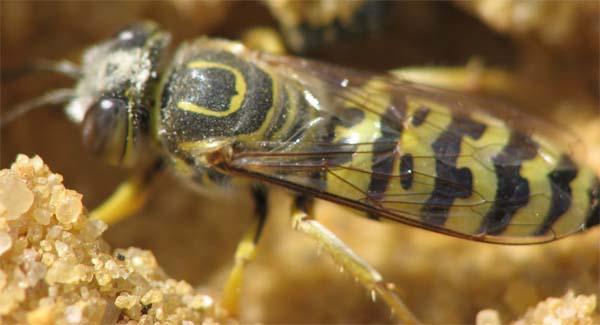 [54.24Kb] |
|
|
|
| zcuc |
Posted on 21-10-2007 01:05
|
|
Member Location: Israel Posts: 492 Joined: 08.10.07 |
Diffrent dots on abdomen
zcuc attached the following image: 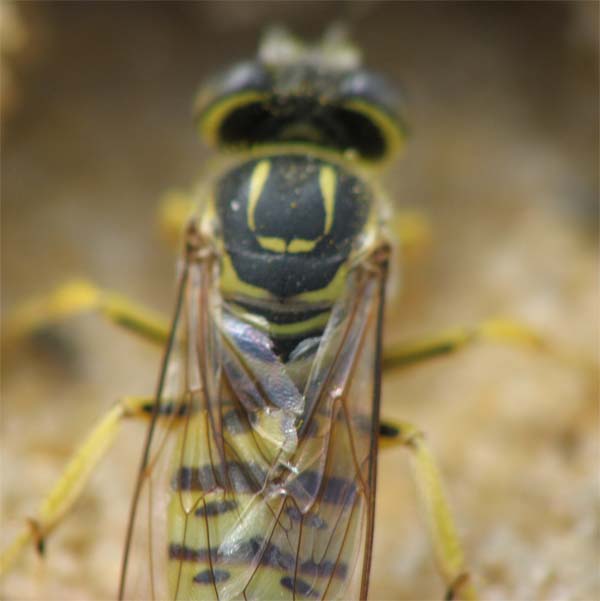 [54.71Kb] |
|
|
|
| zcuc |
Posted on 21-10-2007 01:07
|
|
Member Location: Israel Posts: 492 Joined: 08.10.07 |
Some had faint yellow marks on the thorax.
zcuc attached the following image:  [66.41Kb] |
|
|
|
| zcuc |
Posted on 21-10-2007 01:08
|
|
Member Location: Israel Posts: 492 Joined: 08.10.07 |
And some had none.
zcuc attached the following image: 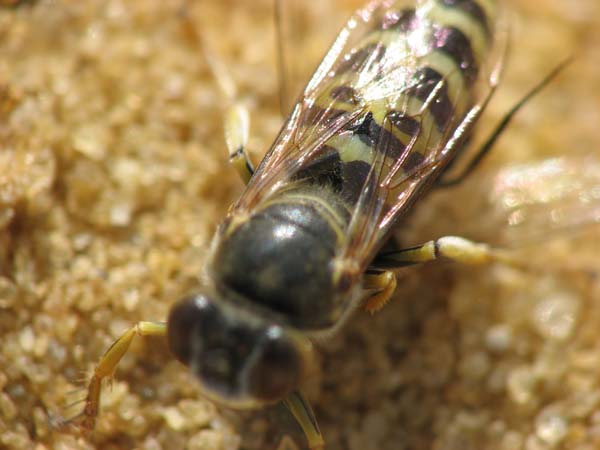 [63.59Kb] |
|
|
|
| jorgemotalmeida |
Posted on 21-10-2007 01:15
|
|
Member Location: Viseu - PORTUGAL Posts: 9296 Joined: 05.06.06 |
Awesome photos! ALmost sure that this is a Bembix sp.  |
| Christian Schmid-Egger |
Posted on 21-10-2007 08:32
|
|
Member Location: Germany, Berlin Posts: 233 Joined: 05.08.05 |
I think it is Bembix oculata, on of the most common species in the Mediterranean area. Black head and the isolated black spots of tergum II are typical for this species. Annother similar species from Israel is arenaria, but it looks somewhat different. Populations of oculata in Egypt and Israel have a variable color pattern on thorax, from all black to an large U-shaped spot. But, species recognition by photos is not 100%, and Bembix is a difficult genus with many species esp. in the SE-Med. area. Where in Israel did you take the photos? In Israel occur some zoogeographical zones close together, with a special fauna in each. Regards, Christian P.S. May we use the photos for our gallery on www.galerie.hymis.de? |
| zcuc |
Posted on 21-10-2007 09:39
|
|
Member Location: Israel Posts: 492 Joined: 08.10.07 |
Sure you can take the images, they were taken at Qiryat Tivon( near Haifa) Do you think they are all of the same species? look at image 2 it has isolated black spots of tergum I, II and III Here is another good image. I notice that some has darker hind wings like in the following image. I'm not sure but maybe they were bigger than the one with more clear hind wings like image #1 P.S I also have a good image on what seem as parasite wasp of Bembix. it was small yellow black wasp that were sneaking after the Bembix to there nest. I'll post here the photo as soon as the forum will allow new threads. zcuc attached the following image: 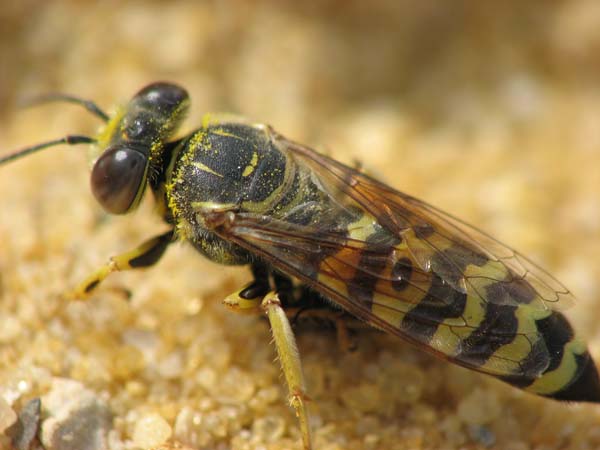 [62.4Kb] Edited by zcuc on 21-10-2007 09:42 |
|
|
|
| jorgemotalmeida |
Posted on 21-10-2007 11:38
|
|
Member Location: Viseu - PORTUGAL Posts: 9296 Joined: 05.06.06 |
zcuc wrote: P.S I also have a good image on what seem as parasite wasp of Bembix. it was small yellow black wasp that were sneaking after the Bembix to there nest. I'll post here the photo as soon as the forum will allow new threads. maybe... a Chrysididae wasp that are kleptoprasites. They stole the food of Crabronidae wasps.  Also there are flies that stole the food to wasps - the Miltogramminae (Sarcophagidae) flies.  |
| Christian Schmid-Egger |
Posted on 21-10-2007 12:21
|
|
Member Location: Germany, Berlin Posts: 233 Joined: 05.08.05 |
Most probably it is one species. Such a color variety is common in Bembix, and what is characteristic for oculata is the black head and scape (first antennal segment), but not the gaster color only. Also in Haifa, the species is probable, because it is a species of the mediterranean area, not reaching the desert (wheras e.g. arenaria occurs mostly in the Negev desert or in the Arava Valley). In 1995, I collected wasps in Israel and also found many Bembix species. The only described wasp parasite of Bembix is the Chrysidid wasp Parnopes grandior s.lat., but it is green/red. Best, you show the photo and we will see what it is. Often, many Sphecid species nests together at on locality. Regards, Christian |
| Christian Schmid-Egger |
Posted on 21-10-2007 12:23
|
|
Member Location: Germany, Berlin Posts: 233 Joined: 05.08.05 |
..and what I forgot: B. oculata normally has brownish dark parts on the wings, but at the end of the season and in older specimens, they may lighten. Regards, Christian |
| zcuc |
Posted on 21-10-2007 22:12
|
|
Member Location: Israel Posts: 492 Joined: 08.10.07 |
Well here it is. Used to sit on higher ground and whenever it saw bembix landing it tried to sneaking into the tunnel the bembix was digging.
zcuc attached the following image: 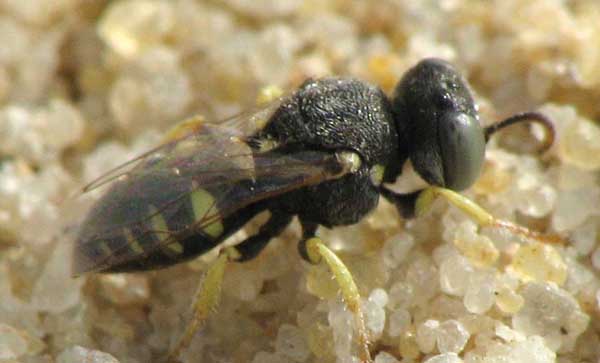 [50.62Kb] |
|
|
|
| Christian Schmid-Egger |
Posted on 22-10-2007 06:58
|
|
Member Location: Germany, Berlin Posts: 233 Joined: 05.08.05 |
It's not a parasite but a Oxybelus spec (Sphecid wasp too). Oxybelus also uses small diptera for prey, but I don't think that it has any relation with Bembix (I don't know anything from literature). Probably it uses the same place for its nest. But, perhaps, any new observation will bring new results. Regards, Christian |
| zcuc |
Posted on 22-10-2007 08:29
|
|
Member Location: Israel Posts: 492 Joined: 08.10.07 |
Your reply is a big surprise. so I guess the the only option is that the Oxybelus was trying to get free lunch by laying the eggs on the bembix food supply. Since this wasp was so small ~5mm I couldn't see the details with my own eyes so it could be possible I saw something else sneaking the nest and was taking photo of diffrent incsects? If I'll have time I'll try to go there again and recheck. Is it possible to get ID? maybe Oxybelus uniglumis? P.S Can I assume this Oxybelus is a female? since is it nesting? |
|
|
|
| Christian Schmid-Egger |
Posted on 25-10-2007 19:54
|
|
Member Location: Germany, Berlin Posts: 233 Joined: 05.08.05 |
It is unprobable that Oxybelus is lucking for 'free lunch' for the babies, because the bembix female feeds (as the only sphecid genus) its larve continuus when growing, so any food will disapear withinin minutes. I think, both species needs the same place or nest entrance. Species ID in Israel is not possible, but uniglumis is excluded. I also cannot recognize the sex, because gaster tip is not visible. Regards, Christian |
| zcuc |
Posted on 26-10-2007 00:37
|
|
Member Location: Israel Posts: 492 Joined: 08.10.07 |
Thanks a lot Christian Schmid-Egger you were very helpful and interesting. It was not so easy to take those little Oxybelus photos and I was so pleased with the result that I was really interested in identification. It was not so easy to take those little Oxybelus photos and I was so pleased with the result that I was really interested in identification.Anyone know were I can find keys for Oxybelus genus? thanks |
|
|
|
| Christian Schmid-Egger |
Posted on 26-10-2007 16:32
|
|
Member Location: Germany, Berlin Posts: 233 Joined: 05.08.05 |
Thats what I like in the net. I am an specialist for sphecid wasps and say, that this specimen on the photo cannot be identified. My base is an experience with this wasps over more than 20 years and also a large Oxybelus collection including a lot of species from Israel. I also told to you that i cannot even recognzie the sex, what normally is much easer than to recognzie a species. Your are proably an amateur? and nevertheless want to identify this specimen? Ok, much luck. For literature, google for 'Pulawski' and 'Crabronidae' and 'Oxybelus'. You will find a checklist for worldwide Oxybelus with detailed literature citations. I think you need only about 15-20 papers to can identify the described species from Israel (about 40 or so?). In Israel, you also will find some undescribed or unclear species. Much luck. Christian |
| zcuc |
Posted on 26-10-2007 16:48
|
|
Member Location: Israel Posts: 492 Joined: 08.10.07 |
Christian Schmid-Egger, Sorry, I didn't realize you were a specialist in the subject and that Oxybelus genus is do hard to identify  .I only thought the images are not clear enough for identification since you said you can't see the gaster tip. .I only thought the images are not clear enough for identification since you said you can't see the gaster tip.So I thought maybe to go there again and try to get one specimen for identification which I thought will be easy to identify with the right keys. I apology if you were offended I never tried do disrespect what you said, just misunderstand. |
|
|
|
| Christian Schmid-Egger |
Posted on 26-10-2007 17:45
|
|
Member Location: Germany, Berlin Posts: 233 Joined: 05.08.05 |
Your answer was not a real problem, and I know that many people don't realize the difficulties in identifying wasps and bees. In most groups, its a difficult job. So, go on taking photos, and perhaps in the next species we are luckier. In any case, I prefer photos from the Mediterranean area, because photos from Central Europe (what we have in other forums as www.insektenfotos.de) are not so interesting after a while. Regards, Christian |
| Jump to Forum: |













